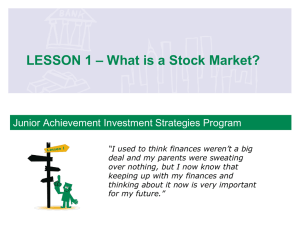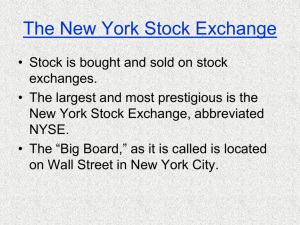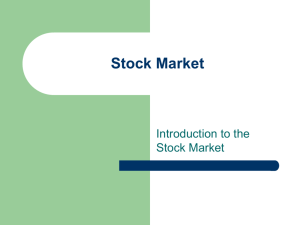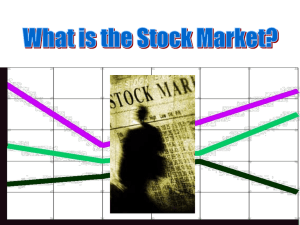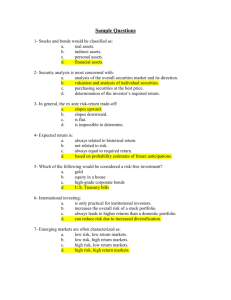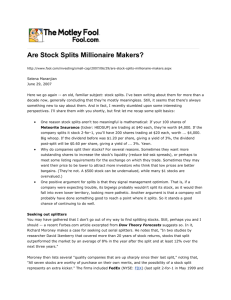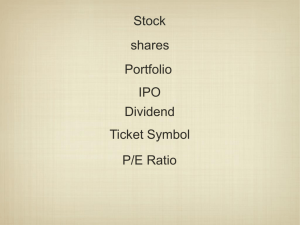Unit 3: Saving & Investing
advertisement
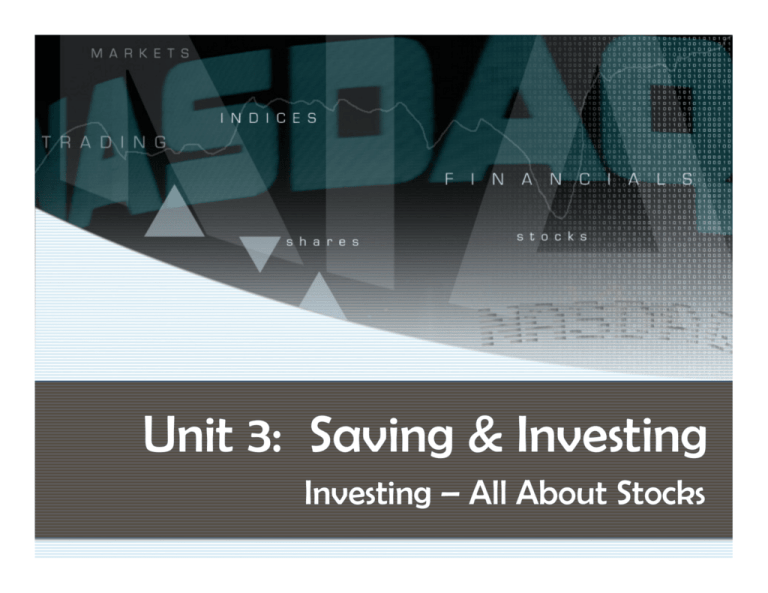
Unit 3: Saving & Investing Investing – All About Stocks What is Stock? Stock is ownership in a company Think about this… Wal-Mart began as a single-store business in Arkansas Dell began when it’s founder, Michael Dell, sold computers out of his dorm room McDonald’s began as a small unknown restaurant What do these companies have in common? They raised capital by selling stock in themselves! What is Stock? Share of stock When you buy a share of stock, you become part owner of that company Stockholders The investors who own the corporation because they own shares of its stock What is Stock? Can all companies sell stock in themselves? No! Businesses owned by one person (sole proprietorship) or two people (partnership) cannot issue stock in their company Corporations are the only businesses allowed to issue stock in themselves Important “Stock” Vocabulary Earnings per Share Amount of profit each share of the company is entitled to “Going Public” When a company sells stock in itself for the 1st time Share Investor’s ownership of the profits, losses, and assets Ticker Symbol Short group of letters representing the stock name What is the Stock Market? The business of buying and selling stocks All stocks listed on the NYSE, NASDAQ, and Amex NYSE: New York Stock Exchange Amex: American Stock Exchange One of the most important sources for companies to raise money Stock Market Memorable Moments Wall Street Crash of 1929 Black Thursday – “The Great Crash” Beginning of the Great Depression Share prices on the NYSE collapsed…and continued to fall for a full month Stock Market Crash in 1987 Black Monday The Dow Jones Industrial Average fell dramatically (22.68%) in just one day NASDAQ National Association of Securities Dealers Automated Quotations American electronic stock exchange Originated in 1971 Largest electronic screen-based equity securities market in the US Approximately 3200 companies In the 1990’s became the popular method of trading stock NASDAQ Advantages: Less expensive to operate Not limited in space Investors can trade more kinds of stock Can operate for longer hours NYSE Composite NYSE = New York Stock Exchange Stock market index covering all common stock listed on the New York Stock Exchange Includes over 2000 stocks Over 1600 are US corporations Over 350 are foreign corporations Dow Jones Industrial Average Stock market index founded by Charles Dow Includes the performance of the industrial component of America’s stock markets Includes 30 of the largest and most widely held public US companies (blue-chip stocks) AT&T, McDonald’s, and Microsoft Boeing and Verizon Communications Coca-Cola and Wal-Mart Stores Exxon Mobil and Walt Disney S&P 500 Standard and Poor’s Index which includes the stocks of 500 Large-cap corporations Companies chosen by a committee They are not necessarily the 500 biggest US companies Based on liquidity, size, and industry There is also a S&P 400, 600, and 1500 Show me the Money… You want to earn a return on your investment through: Dividend payments Increases in the price of the shares of stock Amount of return depends on: How much profit the corporation makes Price of the stock How much stock you own Show me the Money… Dividends By selling the stock Capital gain The profit you earn from selling stock at a higher price than you paid for it Capital loss The loss you take when you sell your stock at a lower price than you paid for it Buy Low, Sell High! How Stock Exchanges Work You can buy and sell stock in two ways: Through a stock exchange Through the electronic system - NASDAQ How Stock Exchanges Work Transaction Sale or purchase of shares; usually conducted through a stock brokerage firm or a stockbroker Stockbroker A person who handles the transfer of stocks and bonds between buyer and seller Brokerage firm A company that specializes in helping people buy and sell stocks and bonds How Stock Exchanges Work A stock exchange is where orders to buy or sell stock are sent and carried out Largest exchange-New York Stock Exchange (NYSE) Stock Prices Price of a stock depends on what other people are willing to pay to buy it Supply and Demand (sound familiar?) Successful company → large profits → high dividends → higher price of shares of stock Unsuccessful company → low dividends → lower price of shares of stock Two Types of Corporate Stock Preferred stock Pays a fixed dividend Common stock Does not pay a set dividend Common vs. Preferred Stock Preferred stock is less risky than common stock Common stock generally has a better return than preferred stock in the same corporation The price of common stock tends to change more than the price of preferred stock Two General Classes of Stock Blue chip stocks Shares in large, well-established corporations History of steady sales and profits Dividends usually grow over time Stock values do not change rapidly Involves lower risk Examples: Procter and Gamble, Ford Two General Classes of Stock Growth stocks Stock in a corporation that is expected to experience rapid growth Pay no, or very small, dividends Return is in the form of large capital gains Growth company has a greater chance of failure Examples: Intel and Microsoft



